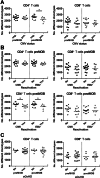Donor CD4 T Cell Diversity Determines Virus Reactivation in Patients After HLA-Matched Allogeneic Stem Cell Transplantation
- PMID: 25873100
- PMCID: PMC4654256
- DOI: 10.1111/ajt.13241
Donor CD4 T Cell Diversity Determines Virus Reactivation in Patients After HLA-Matched Allogeneic Stem Cell Transplantation
Abstract
Delayed reconstitution of the T cell compartment in recipients of allogeneic stem cell grafts is associated with an increase of reactivation of latent viruses. Thereby, the transplanted T cell repertoire appears to be one of the factors that affect T cell reconstitution. Therefore, we studied the T cell receptor beta (TCRβ) gene rearrangements of flow cytometry-sorted CD4(+) and CD8(+) T cells from the peripheral blood of 23 allogeneic donors before G-CSF administration and on the day of apheresis. For this purpose, TCRβ rearrangements were amplified by multiplex PCR followed by high-throughput amplicon sequencing. Overall, CD4(+) T cells displayed a significantly higher TCRβ diversity compared to CD8(+) T cells irrespective of G-CSF administration. In line, no significant impact of G-CSF treatment on the TCR Vβ repertoire usage was found. However, correlation of the donor T cell repertoire with clinical outcomes of the recipient revealed that a higher CD4(+) TCRβ diversity after G-CSF treatment is associated with lower reactivation of cytomegalovirus and Epstein-Barr virus. By contrast, no protecting correlation was observed for CD8(+) T cells. In essence, our deep TCRβ analysis identifies the importance of the CD4(+) T cell compartment for the control of latent viruses after allogeneic stem cell transplantation.
Keywords: Bone marrow; Epstein-Barr virus (EBV); T cell biology; cytomegalovirus (CMV); donors and donation; hematopoietic stem cell transplantation; infection and infectious agents; infectious disease; molecular biology; science; translational research.
© 2015 The Authors. American Journal of Transplantation Published by Wiley Periodicals, Inc.
Figures


 CD4+ T cells preMOB;
CD4+ T cells preMOB;  CD4+ T cells postMOB;
CD4+ T cells postMOB;  CD8+ T cells preMOB;
CD8+ T cells preMOB;  CD8+ T cells postMOB.
CD8+ T cells postMOB.
 CD4+ T cells preMOB;
CD4+ T cells preMOB;  CD4+ T cells postMOB;
CD4+ T cells postMOB;  CD8+ T cells preMOB;
CD8+ T cells preMOB;  CD8+ T cells postMOB.
CD8+ T cells postMOB.Similar articles
-
CMV reactivation drives posttransplant T-cell reconstitution and results in defects in the underlying TCRβ repertoire.Blood. 2015 Jun 18;125(25):3835-50. doi: 10.1182/blood-2015-03-631853. Epub 2015 Apr 7. Blood. 2015. PMID: 25852054 Free PMC article. Clinical Trial.
-
Early cytomegalovirus reactivation leaves a specific and dynamic imprint on the reconstituting T cell compartment long-term after hematopoietic stem cell transplantation.Biol Blood Marrow Transplant. 2014 May;20(5):655-61. doi: 10.1016/j.bbmt.2014.01.018. Epub 2014 Jan 23. Biol Blood Marrow Transplant. 2014. PMID: 24462981
-
Cytomegalovirus-specific CD4+ and CD8+ T-cells follow a similar reconstitution pattern after allogeneic stem cell transplantation.Biol Blood Marrow Transplant. 2002;8(9):501-11. doi: 10.1053/bbmt.2002.v8.pm12374455. Biol Blood Marrow Transplant. 2002. PMID: 12374455
-
Rapid reconstitution of CD4 T cells and NK cells protects against CMV-reactivation after allogeneic stem cell transplantation.J Transl Med. 2016 Aug 2;14(1):230. doi: 10.1186/s12967-016-0988-4. J Transl Med. 2016. PMID: 27484705 Free PMC article.
-
[Collection of hematopoietic progenitor cells from healthy donors].Acta Med Croatica. 2009 Jun;63(3):237-44. Acta Med Croatica. 2009. PMID: 19827352 Review. Croatian.
Cited by
-
T-cell repertoires in refractory coeliac disease.Gut. 2018 Apr;67(4):644-653. doi: 10.1136/gutjnl-2016-311816. Epub 2017 Feb 10. Gut. 2018. PMID: 28188172 Free PMC article.
-
DCLRE1C (ARTEMIS) mutations causing phenotypes ranging from atypical severe combined immunodeficiency to mere antibody deficiency.Hum Mol Genet. 2015 Dec 20;24(25):7361-72. doi: 10.1093/hmg/ddv437. Epub 2015 Oct 16. Hum Mol Genet. 2015. PMID: 26476407 Free PMC article.
-
T-cell receptors identified by a personalized antigen-agnostic screening approach target shared neoantigen KRAS Q61H.Front Immunol. 2025 Mar 17;16:1509855. doi: 10.3389/fimmu.2025.1509855. eCollection 2025. Front Immunol. 2025. PMID: 40165973 Free PMC article.
-
T Cell Repertoire Evolution after Allogeneic Bone Marrow Transplantation: An Organizational Perspective.Biol Blood Marrow Transplant. 2019 May;25(5):868-882. doi: 10.1016/j.bbmt.2019.01.021. Epub 2019 Jan 21. Biol Blood Marrow Transplant. 2019. PMID: 30677510 Free PMC article.
-
Naive T Cells in Graft Versus Host Disease and Graft Versus Leukemia: Innocent or Guilty?Front Immunol. 2022 Jun 20;13:893545. doi: 10.3389/fimmu.2022.893545. eCollection 2022. Front Immunol. 2022. PMID: 35795679 Free PMC article. Review.
References
-
- Theilgaard-Monch K, Raaschou-Jensen K, Andersen H, et al. Single leukapheresis products collected from healthy donors after the administration of granulocyte colony-stimulating factor contain ten-fold higher numbers of long-term reconstituting hematopoietic progenitor cells than conventional bone marrow allografts. Bone Marrow Transplant. 1999;3:243–249. - PubMed
-
- Pan L, Delmonte J, Jr, Jalonen CK, Ferrara JL. Pretreatment of donor mice with granulocyte colony-stimulating factor polarizes donor T lymphocytes toward type-2 cytokine production and reduces severity of experimental graft-versus-host disease. Blood. 1995;12:4422–4429. - PubMed
-
- Seggewiss R, Einsele H. Immune reconstitution after allogeneic transplantation and expanding options for immunomodulation: An update. Blood. 2010;19:3861–3868. - PubMed
-
- Fallen PR, McGreavey L, Madrigal JA, et al. Factors affecting reconstitution of the T cell compartment in allogeneic haematopoietic cell transplant recipients. Bone Marrow Transplant. 2003;10:1001–1014. - PubMed
-
- Maury S, Mary JY, Rabian C, et al. Prolonged immune deficiency following allogeneic stem cell transplantation: Risk factors and complications in adult patients. Br J Haematol. 2001;3:630–641. - PubMed
Publication types
MeSH terms
Substances
LinkOut - more resources
Full Text Sources
Other Literature Sources
Medical
Research Materials

